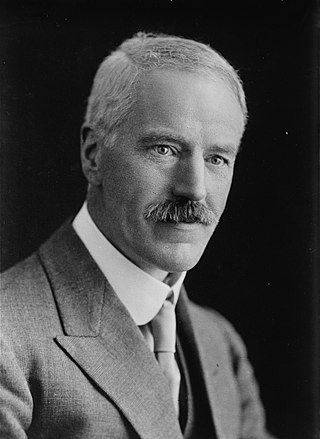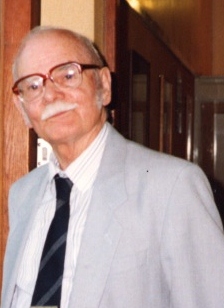Related Research Articles
The Pomp and Circumstance Marches, Op. 39, are a series of five marches for orchestra composed by Sir Edward Elgar. The first four were published between 1901 and 1907, when Elgar was in his forties; the fifth was published in 1930, a few years before his death; and a sixth, compiled posthumously from sketches, was published in 1956 and in 2005–2006. They include some of Elgar's best-known compositions.
In Britain, a brass band is a musical ensemble comprising a standardized range of brass and percussion instruments. The modern form of the brass band in the United Kingdom dates back to the 19th century, with a vibrant tradition of competition based around communities and local industry, with colliery bands being particularly notable. The Stalybridge Old Band was formed in 1809 and was perhaps the first civilian brass band in the world.
Gordon Percival Septimus Jacob CBE was an English composer and teacher. He was a professor at the Royal College of Music in London from 1924 until his retirement in 1966, and published four books and many articles about music. As a composer he was prolific: the list of his works totals more than 700, mostly compositions of his own, but a substantial minority of orchestrations and arrangements of other composers' works. Those whose music he orchestrated range from William Byrd to Edward Elgar to Noël Coward.
The Young Person's Guide to the Orchestra, Op. 34, is a 1945 musical composition by Benjamin Britten with a subtitle Variations and Fugue on a Theme of Purcell. It was based on the second movement, "Rondeau", of the Abdelazer suite. It was originally commissioned for the British educational documentary film called Instruments of the Orchestra released on 29 November 1946, directed by Muir Mathieson and featuring the London Symphony Orchestra conducted by Malcolm Sargent; Sargent also conducted the concert première on 15 October 1946 with the Liverpool Philharmonic in the Philharmonic Hall, Liverpool, England.
English Folk Song Suite is one of English composer Ralph Vaughan Williams' most famous works. It was first published for the military band as Folk Song Suite and its premiere was given at Kneller Hall on 4 July 1923, conducted by Lt Hector Adkins. The piece was then arranged for full orchestra in 1924 by Vaughan Williams' student Gordon Jacob and published as English Folk Song Suite. The piece was later arranged for British-style brass band in 1956 by Frank Wright and published as English Folk Songs Suite. All three versions were published by Boosey & Hawkes; note the use of three different titles for the three different versions. The suite uses the melodies of nine English folk songs, six of which were drawn from the collection made by Vaughan Williams’ friend and colleague Cecil Sharp.
Walter Sinclair Hartley was an American composer of contemporary (classical) music.

Sir Ivor Algernon Atkins was the choirmaster and organist at Worcester Cathedral from 1897 to 1950, as well as a composer of songs, church music, service settings and anthems. He is best known for editing Allegri's Miserere with the famous top-C part for the treble. He is also well known for "The Three Kings", an arrangement of a song by Peter Cornelius as a choral work for Epiphany.

Ian Parrott was a prolific Anglo-Welsh composer and writer on music. His distinctions included the first prize of the Royal Philharmonic Society for his symphonic poem Luxor, and commissions by the BBC and Yale University, and for many leading British musicians. In 1958 his cor anglais concerto was first performed at Cheltenham Festival, and in 1963 his cello concerto was given by William Pleeth and the Hallé Orchestra – both concertos were conducted by Sir John Barbirolli.

The Wand of Youth Suites No. 1 and No. 2 are works for full orchestra by the English composer Edward Elgar. The titles given them by Elgar were, in full: The Wand of Youth First Suite, Op. 1a (1869–1907) and The Wand of Youth Second Suite,.
The First Suite in E♭ for Military Band, Op. 28, No. 1, by the British composer Gustav Holst is considered one of the cornerstone masterworks in the concert band repertoire. Officially premiered in 1920 at the Royal Military School of Music, the manuscript was originally completed in 1909. Along with the subsequent Second Suite in F for Military Band, written in 1911 and premiered in 1922, the First Suite convinced many other prominent composers that serious music could be written specifically for band.

The Sonata in G major, Op. 28 is Edward Elgar's only sonata composed for the organ and was first performed on 8 July 1895. It also exists in arrangements for full orchestra made after Elgar's death.

Frigyes Hidas was a Hungarian composer.

Grand traité d’instrumentation et d’orchestration modernes, abbreviated in English as the Treatise on Instrumentation is a technical study of Western musical instruments written by Hector Berlioz. It was first published in 1844 after being serialised in many parts prior to this date and had a chapter added by Berlioz on conducting in 1855.
Arthur Eckersley Butterworth, was an English composer, conductor, trumpeter and teacher.

The Hope is a work for brass band, percussion, choir, and organ written in 2001 by Frederik Magle, depicting the Battle of Copenhagen in 1801. It consists of two movements with the first being purely instrumental. The choir enters in the second movement using text from Psalm 27.
Spitfire Prelude and Fugue is an orchestral composition by William Walton, arranged and extracted in 1942 from music he had written for the motion picture The First of the Few earlier that year.
Duett for trombone and double bass is a musical work by the English composer Edward Elgar.
Bernard Clements Barrell was an English musician, music educator and composer.
The Overture in D minor is a transcription made in 1923 by Sir Edward Elgar of a musical work by George Frideric Handel composed in 1717-18.
A Moorside Suite (H.173) is a work for brass band by the English composer Gustav Holst. It was commissioned by the BBC and the National Brass Band Festival Committee in 1927 for the final of the 1928 National Brass Band Championships of Great Britain at Crystal Palace. The suite comprises three movements - Scherzo, Nocturne and March.
References
- Allen, Stephen Arthur (Spring, 2019) . 'Sepia Tones and Ghosts Pictured Within: Late Style and Elgar's The Severn Suite', The Musical Times pp1–32
- Kay, Robert (December 2013). The Severn Suite : Manuscripts, Music and Myths. Elgar Society Journal.
- Kay, Esther & Robert (2015). The Severn Suite - Study score. Hambrook, Ledbury, England: Acuta Music. ISBN 978-1-873690-17-8.
- Kennedy, Michael (1987). Portrait of Elgar (Third ed.). Oxford: Oxford University Press. ISBN 0-19-284017-7.
- McVeagh, Diana M. (2007). Elgar the Music Maker . London: Boydell Press. ISBN 978-1-84383-295-9.
- Moore, Jerrold N. (1984). Edward Elgar: A Creative Life. Oxford: Oxford University Press. ISBN 0-19-315447-1.